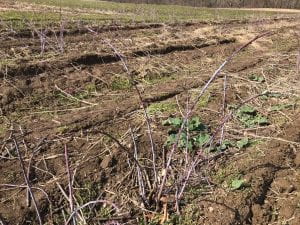Cornell’s Recommendations for U-pick Operations released this week! Read the full document here: https://bit.ly/3aOcNhk
Berry Observations
Strawberries:

With the cold weather, strawberries have not advanced much in the past 2 weeks. Leaves emerging from the crowns are still small. Some are showing leaf diseases already (leaf spot, scorch, blight). Fungicide sprays are recommended at this time if you have had serious leaf infections in past years. I am not seeing much pest pressure with this cold weather. Fields using row covers are more
advanced in development, with flowers at or near bloom. Open flowers need to be protected against botrytis infection with fungicides, especially under warm and rainy conditions. As we approach bloom in the next few weeks, it is important to set up frost protection, whether you are using overhead sprinklers or row covers. This is also the time to talk to your beekeeper if you plan to bring in hives to help with pollination.
Blueberries:
- Most areas of Western NY are still at tight cluster, but may progress quickly with warmer weather.
- Make plans to introduce bumble bee hives into the planting if pollination hasn’t been as strong as you would like. Information below about stocking density and timing.
- Green tip sprays for Mummyberry and Botrytis should be applied soon. Abound and Indar are labelled for both diseases, but there are other choices as well. Again – check the Guidelines or the label.
Top 10 things to do now to optimize blueberry pollination
The article “Invest in pollination for success with highbush blueberries” written by Dr. Rufus Isaacs at Michigan State University outlines the important points below.

- Blueberry pollen is moved by bees, not wind, so high numbers of bees are needed to set a blueberry crop.
- Cultivars vary in their benefit from getting cross pollen versus self-pollen, so field design and stocking should take account of this.
- Honey bees, bumble bees and wild bees contribute to pollination.
- Flowers are receptive to pollen for just a few days. In the hot weather their receptive period is likely to be shorter.
- Stocking recommendations vary by cultivar from lowest (Rubel at 0.5 hives per acre) to highest (Jersey at 2.5 hives per acre), so adjust by cultivar.
- Stock with more bees for higher yielding fields and to increase the chance of full pollination.
- Bumble bee colonies can complement honey bees to improve pollination.
- Wild bees provide significant pollination in some settings, and can perform when honey bees don’t.
- Conserve wild bees by setting aside some farm habitat for their nesting and food after blueberry bloom.
- Minimize pesticide risk to bees by avoiding spraying and bee toxic pesticides during bloom, or apply only late in the day, and follow the label restrictions.
Brambles:
Leaves and new canes are emerging, so it is too late for most herbicides. There is still time to apply fungicides against cane blights, such as Abound, Cuprofix, Badge, Kocide and others.

Brambles are quite sensitive to root/crown diseases and these are particularly common in heavy, poorly drained soils. It is best to AVOID these sites in the first place, but if you see plants dying during the season, or not making it through the winter (especially a mild winter), root diseases like Phytophthora are likely candidates. To protect against more plants dying from this, consider drenching the roots with Aliette, Phostrol, Phosphyte or Ridomil Gold. Some growers feel they have good results with annual applications of one or more of these products. This is also something to consider in strawberry plantings where otherwise healthy plants are collapsing.
Pruning – thin floricane raspberries to 4-6 canes per square foot, keeping rows to about 12 inches wide. Remove skinny canes that won’t be productive. Black raspberries should have winter damage pruned off, and laterals trained to the trellis.
Ribes (currants and gooseberries):

Leaves are emerging well on most varieties. Old wood (over 4 years) should be pruned out. Ribes are susceptible to powdery mildew, preventative applications of sulfur, Actinovate, Rally, Cabrio or Rampart are recommended.
Haskaps:
Currently in full bloom in many areas, as well as reports of damage after recent frosts.
